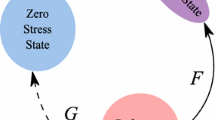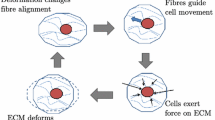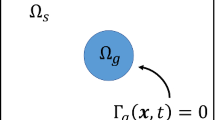Abstract
Tissue equivalents (TEs), formed by entrapping cells in a collagen gel, are an important model system for studying cell behavior. We have previously (Barocas and Tranquillo in J Biomech Eng 117:161–170, 1997a) developed an anisotropic biphasic theory of TE mechanics, which comprises five coupled partial differential equations describing interaction among cells and collagen fibers in the TE. The model equations, previously solved in one or two dimensions, were solved in three dimensions using an adaptive finite-element platform. The model was applied to three systems: a rectangular isometric cell traction assay, an otherwise- acellular gel containing two islands of cells, and an idealized tissue-engineered cardiac valve leaflet. In the first two cases, published experimental data were available for comparison, and the model results were consistent with the experimental observations. Fibers and cells aligned in the fixed direction in the isometric assay, and a region of strong fiber alignment arose between the two cell islands. For the valve problem, the alignment predicted by the model was generally similar to that observed experimentally, but an asymmetry in the experiment was not captured by the model.
Similar content being viewed by others
References
Barocas VH, Girton TS, Tranquillo RT (1998) Engineered alignment in media-equivalents: consequences of cell induced compaction on magnetic prealignment. J Biomech Eng 120:660–666
Barocas VH, Moon AG, Tranquillo RT (1995) The fibroblast-populated microsphere assay of cell traction force—Part 2. Measurement of the cell traction coefficient. J Biomech Eng 117:161–170
Barocas VH, Tranquillo RT (1997a) An anisotropic biphasic theory of tissue-equivalent mechanics: the interplay among cell traction, fibrillar network deformation, fibril alignment, and cell contact guidance. J Biomech Eng 119:137–145
Barocas VH, Tranquillo RT (1997b) A finite element solution for the anisotropic biphasic theory of tissue-equivalent mechanics: the effect of contact guidance on isometric cell traction measurement. J Biomech Eng 119:261–269
Beall MW, Shephard MS (1999) An object-oriented framework for reliable numerical simulations. Eng Comput 15:61–72
Bell E, Ivarsson B, Merrill C (1979) Production of a tissue-like structure by contraction of collagen lattices by human fibroblasts of different proliferative potential in vivo. Proc Nat Acad Sci USA 76:1274–1278
Brenan KE, Campbell SL, Petzold LR (1996) Numerical solution of initial-value problems in differential-algebraic equations. SIAM, North-Holland, New York
Brown RA, Prajapati R, McGrouther DA, Yannas IV, Eastwood M (1998) Tensional homeostasis in dermal fibroblasts: mechanical responses to mechanical loading in three-dimensional substrates. J Cell Physiol 175:323–332
Brown RA, Talas G, Porter RA, McGrouther DA, Eastwood M (1996) Balanced mechanical forces and microtubule contribution to fibroblast contraction. J Cell Physiol 169:439–447
Chen J-K, Haimes HB, Weinberg CB (1991) Role of growth factors in the contraction and maintenance of collagen lattices made with arterial smooth muscle cells. J Cell Physiol 146:110–116
Cruywagen GC, Maini PK, Murray JD (1997) Biological pattern formation on two-dimensional spatial domains: a nonlinear bifurcation analysis. SIAM J Appl Math 57:1485–1509
Donzelli PS, Spilker RL, Ateshian GA, Mow VC (1999) Contact analysis of biphasic transversely isotropic cartilage layers and correlations with tissue failure. J Biomech 32:1037–1047
Driessen NJB, Bouten CVC, Baaijens FPT (2005) Improved prediction of the collagen fiber architecture in the aortic heart valve. J Biomech Eng Trans ASME 127:329–336
Eastwood M, Porter R, Khan U, McGrouther G, Brown R (1996) Quantitative analysis of collagen gel contractile forces generated by dermal fibroblasts and the relationship to cell morphology. J Cell Physiol 166:33–42
Ehrlich HP, Gabbiani G, Meda P (2000) Cell coupling modulates the contraction of fibroblast-populated collagen lattices. J Cell Physiol 184:86–92
Eschenhagen T, Fink C, Remmers U, Scholz H, Wattchow J, Weil J, Zimmermann W, Dohmen HH, Schafer H, Bishopric N, Wakatsuki T, Elson EL (1997) Three-dimensional reconstitution of embryonic cardiomyocytes in a collagen matrix: a new heart muscle model system. FASEB J 11:683–694
Geuzaine C, Remacle JF (2004) Gmsh vers. 1.60, http://www. geuz.org/gmsh/
Girton TS, Oegema TR, Tranquillo RT (1999) Exploiting glycation to stiffen and strengthen tissue equivalents for tissue engineering. J Biomed Mater Res 46:87–92
Girton TS, Tranquillo RT (2002) Confined compression of a tissue-equivalent: collagen fibril and cell alignment in response to anisotropic strain. J Biomech E 124:568–575
Grassl ED, Oegema TR, Tranquillo RT (2003) A fibrin-based arterial media equivalent. J Biomed Mater Res Part A 66A:550–561
Guido S, Tranquillo RT (1993) A methodology for the systematic and quantitative study of cell contact guidance in oriented gels: correlation of fibroblast orientation and gel birefringence. J Cell Sci 105:317–331
Guidry C, Grinnell F (1986) Contraction of hydrated collagen gels by fibroblasts: evidence of two mechanisms by which collagen fibrils are stabilized. Coll Relat Res 6:515–529
Knapp DM, Barocas VH, Moon AG, Yoo K, Petzold LR, Tranquillo RT (1997) Rheology of reconstituted type I collagen gel in confined compression. J Rheol 41:971–993
Kolodney MS, Elson EL (1993) Correlation of myosin light-chain phosphorylation with isometric contraction of fibroblasts. J Biol Chem 268:23850–23855
Kolodney MS, Wyslomerski RB (1992) Isometric contraction by fibroblasts and endothelial cells in tissue culture: a quantitative study. J Cell Biol 117:73–82
L’Heureux N, Germain L, Labbe R, Auger FA (1993) In vitro construction of a human blood vessel from cultured vascular cells: a morphologic study. J Vasc Surg 17:499–509
Long JL, Grassl ED, Isenberg BC, Lee ES, Tranquillo RT (2002) Elastogenesis in collagen and fibrin gel cultures. Faseb J 16:A472–A472
Moon AG, Tranquillo RT (1993) The fibroblast-populated collagen microsphere assay of cell traction force—Part I. Continuum model. AIChE J 39:163–177
Neidert MR, Tower TT, Oegema TR, Tranquillo RT (1999) Fabrication of a tissue-equivalent cardiovascular valve. First Joint BMES/EMBS Conference, Atlanta, GA, IEEE
Neidert MR, Tranquillo RT (2006) Tissue-engineered valves with commissural alignment. Tissue Eng 12:891
Noble PB, Shields ED (1989) Time-based changes in fibroblast three-dimensional locomotory characteristics and phenotypes. Exp Cell Biol 57:238
Ohsumi TK (2003) Efficient methods for solving biomechanical equations. PhD Thesis in computer science. Rensselaer Polytechnic Institute. Troy
Ohsumi TK, Flaherty JE, Barocas VH, Adjerid S, Aiffa M (2000) Adaptive finite element analysis of the anisotropic biphasic theory of tissue-equivalent mechanics. Comput Methods Biomech Biomed Eng 3:215–229
Oster GF, Murray JD, Harris AK (1983) Mechanical aspects of mesenchymal morphogenesis. J Embryol Exp Res 78:83–125
Ozerdem B, Tozeren A (1995) Physical response of collagen gels to tensile strain. J Biomech Eng Trans ASME 117:397–401
Piscatelli SJ, Michaels BM, Gregory P, Jennings RW, Longaker MT, Harrison MR, Siebert JW (1994) Fetal fibroblast contraction of collagen matrices in vitro: the effects of epidermal growth factor and transforming growth factor-beta. Ann Plastic Surg 33:38–45
Remacle JF, Shephard MS (2003) An algorithm oriented mesh database. Int J Numer Methods Eng 58:349–374
Roeder BA, Kokini K, Surgis JE, Robinson JP, Voytik-Harbin SL (2002) Tensile mechanical properties of three-dimensional type I collagen extracellular matrices with varied microstructure. J Biomech Eng 124:214–223
Sawhney RK, Howard J (2004) Molecular dissection of the fibroblast-traction machinery. Cell Motil Cytoskeleton 58:175–185
Shi Y, Vesely I (2003) Fabrication of tissue engineered mitral valve chordae using directed collagen shrinkage. Tissue Eng 9:1233–1242
Shi Y, Vesely I (2004) Characterization of statically loaded tissue-engineered mitral valve chordae tendinae. J Biomed Mater Res 69A:26–39
Smith-Thomas LC, Richardson PS, Rennie IG, Palmer I, Boulton M, Sheridan C, MacNeil S (2000) Influence of pigment content, intracellular calcium and cyclic AMP on the ability of human retinal pigment epithelial cells to contract collagen gels. Curr Eye Res 21:518–529
Taliana L, Evans MD, Dimitrijevich SD, Steele JG (2000) Vitronectin or fibronectin is required for corneal fibroblast-seeded collagen gel contraction. Invest Ophthalmol Vis Sci 41:103–109
Torbet J, Ronziere MC (1984) Magnetic alignment of collagen during self-assembly. Biochem J 219:1057–1059
Wakatsuki T, Kolodney MS, Zahalak GI, Elson EL (2000) Cell mechanics studied by a reconstituted model tissue. Biophys J 79:2353–2368
Zahalak GI, Wagenseil JE, Wakatsuki T, Elson EL (2000) A cell-based constitutive relation for bio-artificial tissues. Biophys J 79:2369–2381
Zhu YK, Umino T, Liu XD, Wang HJ, Romberger DJ, Spurzem JR, Rennard SI (2001) Contraction of fibroblast-containing collagen gels: initial collagen concentration regulates the degree of contraction and cell survival. In Vitro Cell Dev Biol Animal 37:10–16
Zienkiewicz OC, Zhu JZ (1987) A simple error estimator and adaptive procedure for practical engineering analysis. Int J Numer Methods Eng 24:337–357
Author information
Authors and Affiliations
Corresponding author
Rights and permissions
About this article
Cite this article
Ohsumi, T.K., Flaherty, J.E., Evans, M.C. et al. Three-dimensional simulation of anisotropic cell-driven collagen gel compaction. Biomech Model Mechanobiol 7, 53–62 (2008). https://doi.org/10.1007/s10237-007-0075-0
Received:
Accepted:
Published:
Issue Date:
DOI: https://doi.org/10.1007/s10237-007-0075-0




